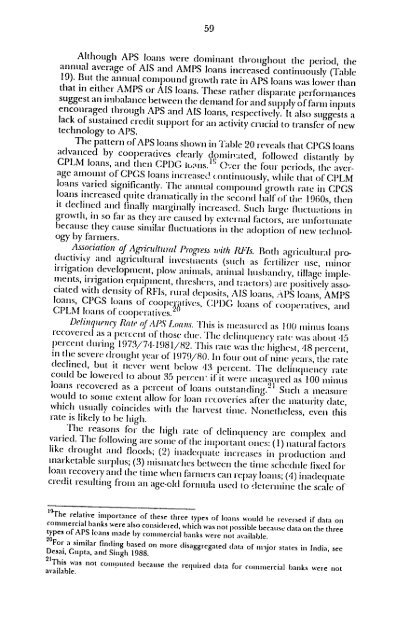I Fiance Apicultural
I Fiance Apicultural
I Fiance Apicultural
Create successful ePaper yourself
Turn your PDF publications into a flip-book with our unique Google optimized e-Paper software.
59<br />
Although APS loans were dominant thr'oughout tile period, the<br />
annual average of AIS and AMPS loans increased continuously (Table<br />
19). But the annual compound growth rate in APS loans was lower than<br />
that in eithcr AMPS or AIS loans. These rather disparate performances<br />
suggest an imbalance between the demand for and supply of farin inputs<br />
encouraged through APS and AIS loans, respectively. It also suggests a<br />
lack of sustained credit support for an activity crucial to transfer of ncw<br />
technology to APS.<br />
7he pattern of APS loans shown in Table 20 reveals that CPGS loans<br />
advanced by cooperatives clearly domiusted, followed distantly by<br />
CPLM loans, and then CPI)G Iok1s.ils Over the four periods, the average<br />
amount of CPGS loans increased continuously, while that of CPLM<br />
loans varied significantly. The annual Comipotnd growth rate in CPGS<br />
loans increased quite draniatically il tile second half of' the 1960s, then<br />
it declined a id finallyimarginally incrCased. Such large flncti tions ill<br />
growth, in so far as they are caused by cxternal factors, ai unfortunate<br />
because they cause similar fluctuations in the adoption of new teclnology<br />
by farmers.<br />
Association of Agpidltural Progess with R1Is. Both agricultur.d productivity<br />
and agricultural investments (such as fertilizer use, minor<br />
irrigation development, plow animnals, animal hus)andry, tillage implements,<br />
iri|gation equipment, threshers, and t:actors) are positively associated<br />
with deisity of RFIs, rural deposits, AIS loans, AS loans, AMPS<br />
loans, CPGS loans of coope t'3ivcs, CPI)G loans of' cooperatives, and<br />
CPLM loans of' cOOlpeatives.<br />
Delinqueno Rate of /11'S Loans. This is mlasnrcd as 100 nlilis loans<br />
recovered as a peceimt of those due. The delinquency ratc was about ,15<br />
perceit during 1973/71-1981/82. This rate was the highet, '8 percent,<br />
in the severe dirought year of 1979/80. fi four out oflint years, the rate<br />
declined, but it never went below '13 pcrca. The delinquency rate<br />
could be lowered to about 35 p)eccni if it wer- measrecd as 100 Iinus<br />
loans recovered as a percent of loans ouitstaniding.2 1 Such a measure<br />
would to some extent allow for loan recoveries after the naturity (late,<br />
which usually coincides with the hat-vest time. Nonetheless, even this<br />
rate is likely to be high.<br />
'lie reasons for tile high rate of delinquency are complex and<br />
varied. The following arC sotire of'tle. iiportant ones: (1) natuti-al factors<br />
like drought and floods; (2) inadequate increases in production and<br />
marketable su-)lus; (3) misntatches between the time schedule fixed for<br />
loan recovery and the tiic when farniers can repay loans; ('4) inadequate<br />
credit resulting fiot i an age-old formula used to determiie the scale of'<br />
1 9 The relative importance of these three types of loans would<br />
commercial<br />
be reversed<br />
banks<br />
if data<br />
were<br />
on<br />
also considered, which was not possible because data<br />
types<br />
on the<br />
of<br />
three<br />
APS loans made by commercial banks were not available.<br />
20<br />
For a similar finding based on more disaggregated data of uvijor states in India, see<br />
Desai, Gupta, and Singh 1988.<br />
2<br />
'This was not computed because the required data for comnmercial banks were not<br />
available.

















